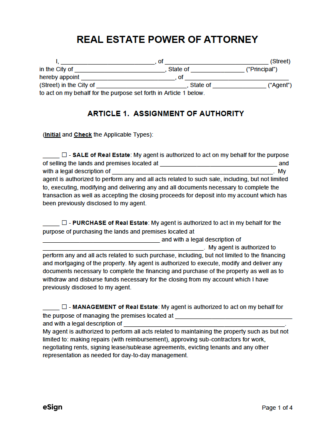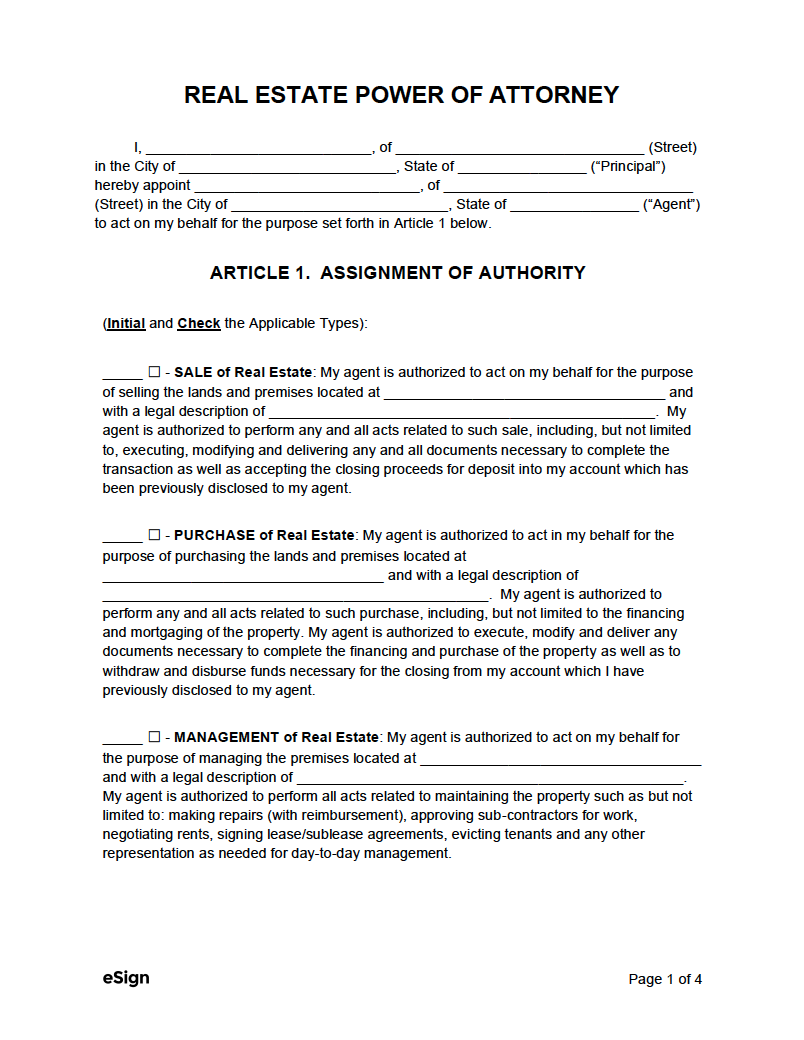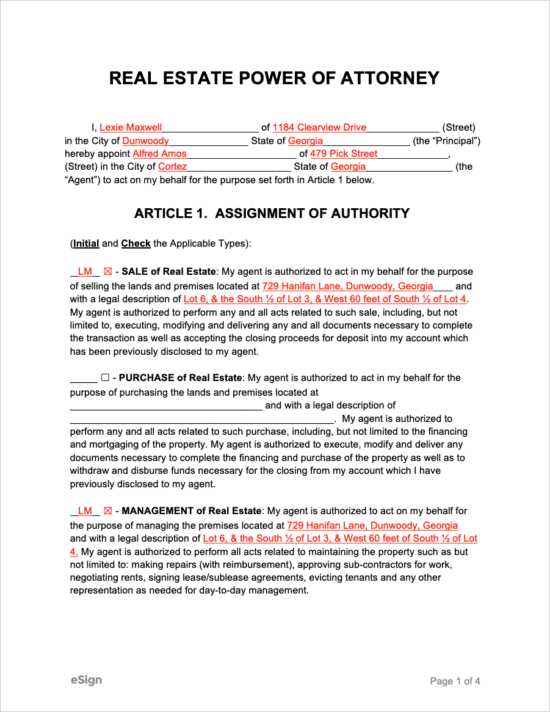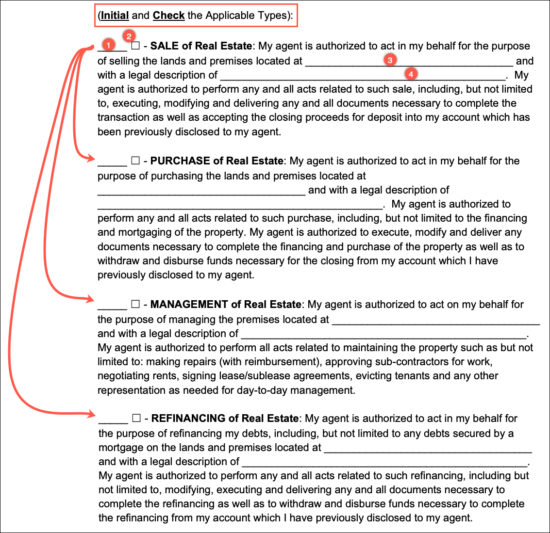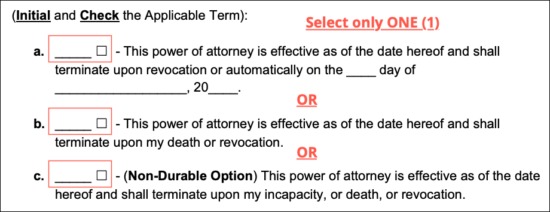Used for giving an agent permission to:
- Manage;
- Sell;
- Purchase;
- Mortgage (refinance); or
- Transfer (convey) real estate on behalf of the owner.
By State
- Alabama
- Alaska
- Arizona
- Arkansas
- California
- Colorado
- Connecticut
- Delaware
- Florida
- Georgia
- Hawaii
- Idaho
- Illinois
- Indiana
- Iowa
- Kansas
- Kentucky
- Louisiana
- Maine
- Maryland
- Massachusetts
- Michigan
- Minnesota
- Mississippi
- Missouri
- Montana
- Nebraska
- Nevada
- New Hampshire
- New Jersey
- New Mexico
- New York
- North Carolina
- North Dakota
- Ohio
- Oklahoma
- Oregon
- Pennsylvania
- Rhode Island
- South Carolina
- South Dakota
- Tennessee
- Texas
- Utah
- Vermont
- Virginia
- Washington
- West Virginia
- Wisconsin
- Wyoming
Contents |
What is Real Estate Power of Attorney?
A real estate power of attorney is a document used for appointing an agent or property manager to handle one’s residential or commercial property. This can include signing rental agreements, representing the principal at closings, and handling any other decisions or responsibilities the principal may need. Unlike other types of POAs, the form can be made to be durable OR non-durable depending on the purposes the principal has for using the form.
What Can it Be Used For?
As an overview, one can use the document to do the following regarding real property:
- Manage / request repairs / hire labor;
- Sell / exchange / convey / quitclaim;
- Purchase / buy / lease / receive;
- Mortgage;
- Insure;
- Pay taxes; and
- Much more.
How to Use a Real Estate POA
Step 1 – Determine the Powers + Term
The principal can structure the form to provide the agent with whatever powers they feel are necessary. Whatever the principal chooses, they should make sure the powers are detailed clearly on the form, leaving nothing to assumption.
Because the POA type is non-durable, it will automatically terminate should the principal become mentally incapable of making decisions or in the event of their death. However, the principal should specify whether or not the agent’s powers extend in perpetuity or are limited to a single task or period of time. In other words, if the agent will be assisting with the one-time sale of a property, the form should state that their powers terminate after the sale. On the other hand, a property management company assigned as an agent should be given continuous powers.
Step 2 – Select the Agent
Federal and state law provides little restriction on who can serve as an agent. Additionally, the agent is not required to be a person – entities (businesses) can be nominated as an attorney-in-fact as well. For property transactions, the principal should choose a realtor, attorney, or another person experienced in buying and selling real estate. Likewise, the principal should choose an experienced property manager or management company if they need to have tenants screened, leases signed, the property cleaned and maintained, and so on.
Step 3 – Sign & Distribute
At this point, the agent will have accepted their nomination, understand exactly what is required of them, and be prepared to carry out their assigned duties. The principal will then need to sign the form. Depending on the state, it may also need to be notarized. However, proceeding with notarization regardless of what is required is recommended to ensure it is accepted by whoever it is presented to. The principal should then make copies of the form and personally deliver the POA to recipients, or give the agent a copy to display as necessary.
Real Estate POA Laws: By State
| STATE | STATUTE |
| Alabama | § 26-1A-204 |
| Alaska | § 13.26.645 |
| Arizona | N/A |
| Arkansas | Title 18, Chapter 12, Subchapter 5 and § 28-68-204 |
| California | § 4123(b) |
| Colorado | § 15-14-727 |
| Connecticut | § 1-351c |
| Delaware | N/A |
| Florida | § 689.111 |
| Georgia | N/A |
| Hawaii | § 551E-34 |
| Idaho | § 15-12-204 |
| Illinois | 755 ILCS 45/3-4 |
| Indiana | § 30-5-5-2 |
| Iowa | § 633B.204 |
| Kansas | § 58-654 |
| Kentucky | § 382.370 |
| Louisiana | N/A |
| Maine | § 5-934 |
| Maryland | § 4-107 |
| Massachusetts | N/A |
| Michigan | § 556.304 |
| Minnesota | § 523.24 |
| Mississippi | N/A |
| Missouri | § 404.710 |
| Montana | § 72-31-339 |
| Nebraska | § 30-4027 |
| Nevada | § 162A.480 |
| New Hampshire | § 564-E:204 |
| New Jersey | § 46:2B |
| New Mexico | § 45-5B-204 |
| New York | § 5-1502A |
| North Carolina | § 32C-3-303 |
| North Dakota | Ch. 30.1-30 |
| Ohio | § 1337.45 |
| Oklahoma | 58 O.S. § 1006 |
| Oregon | § 127.045 |
| Pennsylvania | § 5603(i) |
| Rhode Island | § 18-6-3 |
| South Carolina | § 62-8-204 |
| South Dakota | § 59-3-12 |
| Tennessee | § 34-6-109 |
| Texas | § 752.102 |
| Utah | N/A |
| Vermont | § 305 |
| Virginia | § 64.2-1625 |
| Washington | § 11.125.270 |
| West Virginia | § 39B-2-104 |
| Wisconsin | § 244.44 |
| Wyoming | N/A |
Sample
Download: PDF, Word (.docx), OpenDocument
How to Write
Download: PDF, Word (.docx), OpenDocument
Step 1 – Principal + Agent
The eight (8) fields found at the top of the first (1st) page are used for identifying the principal and the agent. The following information should be entered into the applicable fields by the principal:
- Full name of the principal;
- Principal’s street name & number (#);
- Principal’s city name;
- Principal’s state;
- Agent’s full name;
- Agent’s street name and number (#);
- Agent’s city; and
- Agent’s state name.
Step 2 – Powers (Art. 1)
The principal can grant their agent up to four (4) powers regarding the property in question. A minimum of one (1) power needs to be selected. For each power the principal wishes to grant to the agent, they need to complete the following steps:
- Inscribe their initials to the left of the power;
- Check the box next to their initials;
- Enter the full address of the property; and
- Provide the legal description of the real estate (which can be found on the most recent deed).
To repeat, the principal needs to complete steps 1-4 (above) for EVERY specific type of authorization.
Step 3 – Term (Art. 3)
This section is used for indicating when the POA will terminate. The principal will need to initial their name and check the corresponding box next to the option they choose. They can only choose ONE of the following three options:
- Option (a.) – The POA will end on a specific date. If selected, enter the date (day, month, and year) on which the contract will end.
- Option (b.) – The POA will remain in effect (regardless of the principal’s mental state) until the principal dies or manually revokes the POA.
- Option (c.) – The POA will terminate automatically should the principal lose their ability to communicate their needs (i.e., incapactitated).
Step 4 – State (Art. 5)
Enter the name of the state in which the principal’s property is located.
Step 5 – Principal’s Signature (Art. 6)
At the top of the third page the principal will need to enter the day, month, and year they are signing the POA, followed by their signature and printed name. Depending on the signing requirements of the principal’s state, they may need to have their signature notarized or observed by one (1) or more witnesses. The principal CANNOT sign until they are in the presence of the witness(es) or Notary Public.
Step 6 – Agent’s Signature
Having the agent sign the POA is not a requirement but adds proof that the representative understands their nomination as an agent and the responsibilities that go along with it. To complete this section, the agent will need to provide the following information:
- Their signature (by hand or online using eSign); and
- Their full name beneath their signature.
